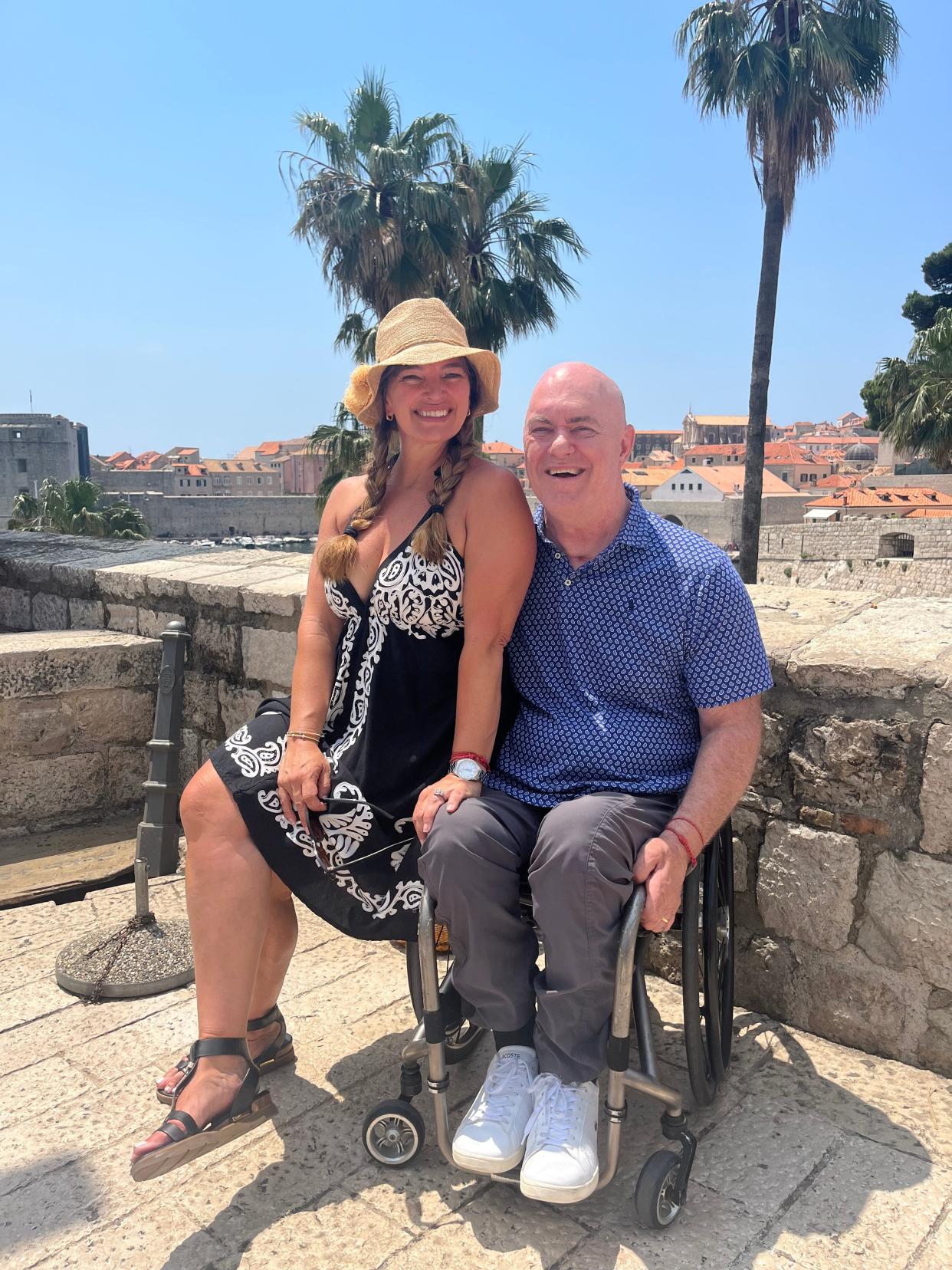The newer, the better: How wheelchair users can travel smoothly
Chris Ricci can walk only short distances at a time, but he has traveled the world on his scooter.
The 57-year-old U.S. Army veteran has limited mobility stemming from a foot injury he sustained in the 1980s and related complications has found cruises an accessible way to explore destinations like Alaska or the Caribbean. Just this month, he, his wife and friends took a week-long Royal Caribbean International cruise to Belize, Honduras and Mexico.
Ricci, who is based in Lakeland, Florida, simply had to drive to Tampa to board the Enchantment of the Seas. “I think it’s pretty easy,” he told USA TODAY. They booked an accessible stateroom for the first time, too.
“It was really big,” said Ricci, who chronicles his cruises and other travels on his YouTube channel, Scootin Around the World. “I had no problem getting the scooter into the room.”

Cruise ships can offer guests who use mobility devices an accessible, streamlined way to travel. But some extra planning can go a long way toward ensuring the trip goes smoothly. Here’s what to know.
How this adult-only cruise line integrated accessibility into its experiences
Do cruise ships have accessible staterooms for mobility devices?
Cruise lines do offer accessible staterooms, but they’re not all the same. “Make sure that you have the accessible room that's best for you,” said Joy Burns, organization and PR manager at accessible travel booking platform Wheel the World.
For instance, some staterooms may be better suited to motorized wheelchair users, but the setup may not be conducive for passengers who use other kinds of devices, according to her husband, Bert, who has been paralyzed since 1982 and has taken more than 20 cruises.
“If I got a wheelchair-accessible room that's made for a power wheelchair with a Hoyer lift, the bed’s up real high,” he said. “I can’t transfer with a high bed. I use a manual wheelchair, so I’m down low.”
Standard staterooms may also be able to accommodate mobility devices, but guests should familiarize themselves with cruise lines’ requirements.

Passengers booking a standard cabin on Carnival Cruise Line ships must have devices that can fit through a 22-inch-wide doorway, according to its website. The devices must also fold and collapse to allow for safe exit from the room (passengers cannot store mobility devices in corridors or public spaces).
“Guests who bring scooters that are larger than 21" (53.34 cm) wide, or travel with multiple scooters in the same stateroom, must purchase a fully accessible stateroom with a wider doorway (32”, 81.3 cm), or rent a smaller scooter appropriately suited for their stateroom,” the line said on its website. “Guests may be required to have their scooters sized at the time of check-in to ensure it fits in the stateroom.”
Major cruise lines typically have accessibility departments that can help guests navigate the process, according to Sylvia Longmire, an accessible travel writer who runs the blog and travel brand Spin the Globe.
“Talk to the accessibility department to ask the questions and let them know what kind of equipment you're bringing if you're bringing your own stuff,” said Longmire, who has multiple sclerosis and has taken over 30 cruises, most of which have been with a scooter or wheelchair. “Let them know what your ability or disability is, what your level is, what your accessibility requirements are. And that way, they can tell you what kind of cabin you might need, what location, (information) about the ship, and everything before you even call to make the reservation.”
For those booking through a travel agent, she said she “highly” recommends working with someone who has a disability or is an expert in accessible travel.
What cruises are best for guests with mobility devices?
Some destinations may also be better suited to guests with mobility devices than others.
Once, during a New Zealand cruise, the Burnses’ ship hit some rough water, causing Bert to roll out of the casino and crash into the bar (though no one was hurt). Joy recommended researching the conditions of the seas. (Click here for USA TODAY’S guide to the best times to cruise by region.)
She added that expedition cruises, which often feature activities that require guests to get on and off Zodiac boats, may not be as accessible.
What cruise ship is best for guests with mobility devices?
New ships tend to have more features that can make a trip easier for guests with mobility devices, said the Burnses and Longmire. Those include automatic sliding doors in public spaces, stateroom locks that allow passengers to wave their key to open the door and pool lifts.
“The newer the ship, the better the accessibility,” said Longmire.
Can I get a mobility device through a cruise line?
Guests can arrange to rent mobility devices through vendors like Scootaround or Special Needs at Sea (Longmire is a contract employee for Scootaround).
Rentals may also be available at the cruise terminal, and some lines have a limited number of scooters and wheelchairs available on the ship, according to Longmire. She estimated rentals can run from roughly $80 to $250 depending on the type of equipment, the length of time guests need it and other factors.
Do cruise lines have accessible excursions?
Yes, but options may be limited. Joy said accessible shore excursions available through cruise lines are “few and far between,” and she and Bert have taken cruises where there were none available through the cruise line at all.
Longmire noted that “cruise lines are entirely dependent on the availability of excursions with whoever they're contracting with.” If a given destination doesn’t have wheelchair taxis, for example, that limits cruise lines’ offerings.
Are there blind scuba divers? Here's the accessible way anyone can explore the ocean
When they are available through the line, Longmire said many of them are what she calls windshield tours – bus tours with a group of other passengers that might include one or two 15-minute stops to take photos. “And the rest of it is just seeing everything out the window,” she said.
However, she added that cruise lines “get a little bit better” each year about offering those.
Joy said passengers can also book accessible shore excursions through companies like Wheel the World. Longmire has had luck booking shuttles and tours directly through providers in various ports as well, though guests should take care to be back in time before the ship leaves.
Are tender ports accessible?
When it comes to accessibility at tender ports – where guests have to take a small vessel from the ship to shore – Longmire said it’s “not very black and white.” Cruise ships may let guests board tenders and some have technology to help passengers with wheelchairs do so, but the port’s capabilities may be different.
“Just because you're able to get from the ship to the tender doesn't mean that you'll be able to get from the tender to the dock,” said Longmire.
Rules may differ as well, with some lines allowing guests in manual wheelchairs to use tenders but prohibiting motorized devices. She recommended checking with the accessibility department about those policies.
The Burnses, for their part, have generally found tender ports to be inaccessible, and Joy suggested travelers review itineraries to see how many they include.
Overall, Longmire said her experience on cruises has been “really good,” both for their accessibility and convenience (you can visit multiple places but unpack once, for instance). “I always recommend to wheelchair users for their first travel experience, like, if you don't get seasick and you’re okay with cruises, a cruise is the way to go.”
Nathan Diller is a consumer travel reporter for USA TODAY based in Nashville. You can reach him at ndiller@usatoday.com.
This article originally appeared on USA TODAY: Can I take a mobility device on a cruise? What you should know.